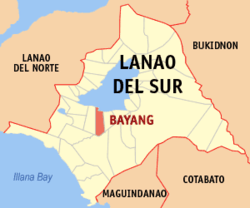Bayang, Lanao del Sur
| Bayang | |
|---|---|
| Municipality | |
 Map of Lanao del Sur with Bayang highlighted | |
.svg.png) Bayang Location within the Philippines | |
| Coordinates: 07°47′35″N 124°11′31″E / 7.79306°N 124.19194°ECoordinates: 07°47′35″N 124°11′31″E / 7.79306°N 124.19194°E | |
| Country | Philippines |
| Region | Autonomous Region in Muslim Mindanao (ARMM) |
| Province | Lanao del Sur |
| Barangays | 49 |
| Government[1] | |
| • Mayor |
Aslanie Balt = Vice Mayor= Johanisa Datudacula-Radiamoda (2016 elected) |
| Area | |
| • Total | 230.00 km2 (88.80 sq mi) |
| Population (2010)[2] | |
| • Total | 21,472 |
| • Density | 93/km2 (240/sq mi) |
| Time zone | PST (UTC+8) |
| ZIP code | 9309 |
| Dialing code | +63 (0)63 |
| Income class | 5th |
Bayang is a fifth class municipality in the province of Lanao del Sur, Philippines. According to the 2010 census, it has a population of 21,472 people.[2]
Battle of Bayang
In May 1902, during the Moro Rebellion (also known as the Moro–American War[3]), Bayang was the site of a clash between Moro rebels and American troops that became known as the Battle of Bayang. The American troops, three infantry battalions and a battery of artillery totaling some 1200 men, were led to Bayang by colonel Frank Baldwin to demand the extradition of the Moros responsible for the ambushing and killing of two American soldiers at the construction of a road from Iligan to Lake Lanao, two months earlier.[4]
When the sultan of Bayang refused, Baldwin's troops attacked and captured the nearby cotta (fortress; "small, castle-like structures with thick, high walls"[5]) of Binidayan on 2 May. They subsequently attempted to capture the cotta of Pandapatan, which resisted the artillery fire and was only subdued the next day after hand-to-hand combat between Moros and Americans. The number of Moro casualties is estimated at 300 to 400, including the sultan of Bayang and his brother. On the American side, ten soldiers were killed and some forty wounded.[4][5]
The cotta of Pandapatan has been preserved as a historical monument; the fallen of the Battle of Bayang are considered martyrs by Filipino Muslims.[3]
Barangays
Bayang is politically subdivided into 49 barangays.
- Bagoaingud
- Bairan (Pob.)
- Bandingun
- Biabi
- Bialaan
- Bubong Lilod
- Bubong Raya
- Cadayonan
- Cadingilan Occidental
- Cadingilan Oriental
- Condaraan Pob. (Condaraan Dimadap)
- Cormatan
- Gandamato
- Ilian
- Lalapung Central
- Lalapung Proper
- Lalapung Upper
- Linao
- Linuk (Pob.)
- Liong
- Lumbac
- Cadayonan Lumbac
- Maliwanag
- Mapantao
- Mimbalawag
- Palao
- Pama-an
- Pamacotan
- Pantar
- Parao
- Patong
- Bayang Pobl.
- Porotan
- Rantian
- Cadayonan Raya
- Rinabor
- Samporna (Pob.)
- Sapa
- Silid
- Sugod
- Sultan Pandapatan
- Sumbag (Pob.)
- Tagoranao
- Tangcal
- Tangcal Proper
- Tomarompong
- Tomongcal Ligi
- Torogan
- Tuca (Pob.)
Demographics
| Population census of Bayang | ||
|---|---|---|
| Year | Pop. | ±% p.a. |
| 1990 | 18,928 | — |
| 1995 | 20,060 | +1.09% |
| 2000 | 21,020 | +1.01% |
| 2007 | 24,185 | +1.95% |
| 2010 | 21,472 | −4.24% |
| Source: National Statistics Office[2] | ||
Education
Secondary Schools:
- Mauyag C. Papandayan National High School, Rinabor, Bayang, Lanao del Sur
- Bayang National High School, Biabi, Bayang, Lanao del Sur
- Upper Bayang National High School,Raya Bubong, Bayang, Lanao del Sur
Elementary Schools:
- Dandamun Central Pilot School,Lower Bayang District
- Rantian Elementary School
- Linuk Primary School
- Gandamato Primary School
- Anal Primary School
- Cota Primary School
- Sumbag Primary School
- Samporna Primary School
- Tomarompong Primary School
- Balidong-Adil Primary School
- Sultan Pandapatan Central Elementary School, Upper Bayang District
- Tagoranao Elementary School
- Bandingun Elementary School
- Linao Elementary School
- Palao Elementary School
- Raya Bubong Primary School
- Ilian Primary School
- Sugod Primary School
- Cobo Primary School
- Cadingilan Primary School
- Mimbalawag Primary School
- Bialaan Primary School
- Biabi Primary School
- Diwan Central Elementary School, Diwan District
- Bubong Elementary School
- Lucman Elementary School
- Cadayonan Primary School
- Dimunda Primary School
- Raya Cadayonan Primary School
- Patong Primary School
- Sapa Primary School
- Ligui Primary School
- Lumbac Primary School
- Toca Primary School
- POINT OF INTEREST-
- Padang Karbala Shrine located at Sultan Pandapatan Bayang
- Malaa Alad
- Dandamun Mosque
References
- ↑ "Official City/Municipal 2013 Election Results". Intramuros, Manila, Philippines: Commission on Elections (COMELEC). 1 July 2013. Retrieved 5 September 2013.
- 1 2 3 "Total Population by Province, City, Municipality and Barangay: as of May 1, 2010" (PDF). 2010 Census of Population and Housing. National Statistics Office. Archived from the original (PDF) on 2 April 2016. Retrieved 20 June 2014.
- 1 2 Antonio J. Montalvan II (13 May 2002). "The war that no one remembers". Philippine Daily Enquirer.
- 1 2 Paul J. Springer (2009). "Bayang, Battle of". In Spencer Tucker. The Encyclopedia of the Spanish-American and Philippine-American Wars. 1. ABC-CLIO. pp. 49–50.
- 1 2 Alexander M. Bielakowski, ed. (2013). Ethnic and Racial Minorities in the U.S. Military. ABC-CLIO. p. 444.
External links
- Philippine Standard Geographic Code
- Philippine Census Information
- Local Governance Performance Management System
 |
Lake Lanao |  | ||
| Binidayan | |
Lumbatan Lumbaca-Unayan | ||
| ||||
| | ||||
| Marogong |